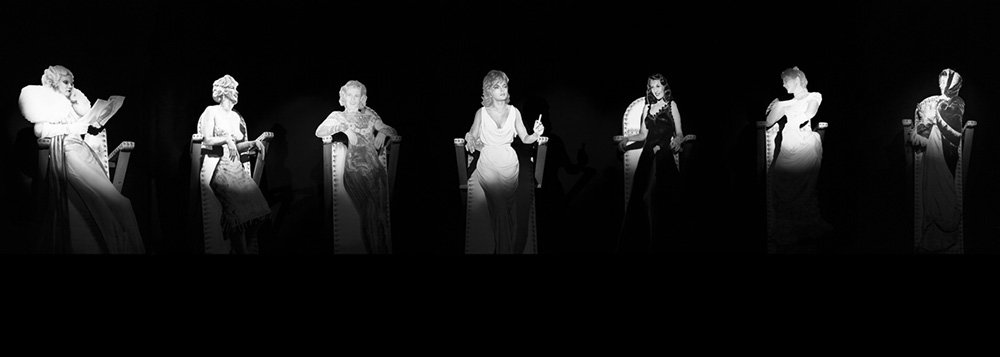That’s Right Mister…
David Anderson
The Cob Gallery Writer in Residence
Featured in Measuring Elvis, 2015
That’s Right Mister and How’s your Fairytale Coming Along? Installation View
Graced with the ability to invest a frozen frame with all the heat of a moment, Nina Mae Fowler’s large-scale drawings based on film stills have won her increasing acclaim. Having originally graduated in sculpture from Brighton University, Fowler’s singular amalgamation of three-dimensional and graphic forms have recently seen her exhibiting in Paris, Hong Kong, Aschaffenburg and London, where she is represented by the Saatchi Gallery.
Steeped in the saturated glitz of golden-era Hollywood, Fowler’s work is often located in the realm between a surface’s shimmer and an anxiety over the emptiness it might conceal. Citing Kenneth Anger’s Hollywood Babylon as a formative influence, she pays due attention to what Anger called “the scalding reality behind the glittering facade of America’s dream factory”. It is in this vein that her work often seeks to extend the limits of the flat, cinematic image’s pliability, revelling in the raw emotive depth that it both emits and conceals.
At the centre of Fowler’s new show at the The Cob Gallery, London, are her life-size ‘leaning boards’ — reconstructions of the off-screen props on which film-starlets would rest between takes, in order to relax without crumpling their dresses. Forgotten today and overlooked in their time, these boards seemed to exist in a perpetual state of poise between their own mundanely mechanical weight and the supposed lightness of the stardust they supported.
Removed from the film-set to the gallery space, these boards seem suddenly to encapsulate Hollywood’s particular strangeness — the appearance of leisure as a form of work; ease that becomes exhausting. Having embellished her versions with hand-drawn images of the stars they would originally have propped up, Fowler adds a new value to the otherwise unacknowledged, drawing out and confounding the distinction between prosaic practicality and poetic aura. The boards become a model of the star’s dislocation from their own image, and yet for us too they prove problematic: invited to lean as the actresses might have leaned, we too are restricted by an image that is always in the way, taking up the surface as surface, reminding us of the prosaic functionalism at the heart of it all.
And while our attention is drawn ever more towards the question of what lies beneath the glamour, the boards — as life-size cut-outs — also toy with the notion of the ‘collector’s item’, grabbing in two dimensions at the emotive, cinematic depth that can reappear only in passing, in the movement of frames. Out of this infinite exchange of stillness and motion, Fowler has found another angle, crafting a set of objects to be treasured in new ways. Her use of labour-intensive manual draughtsmanship is integral to this, working in counterpoint with the instantaneousness of cinematography and the conventional immediacy of monochrome, wrenching the fullest possible capacity from the static image before it passes swiftly by.

